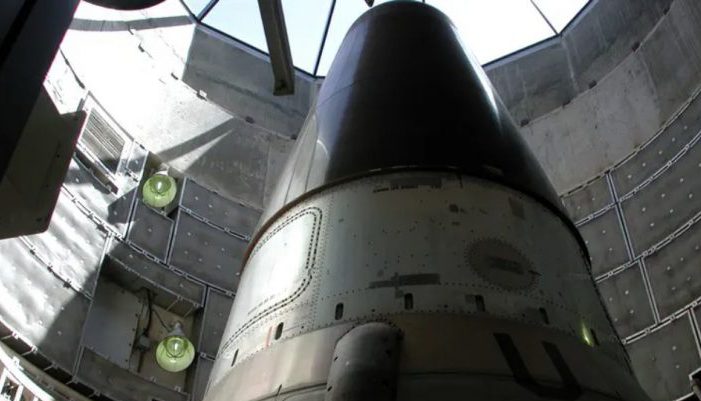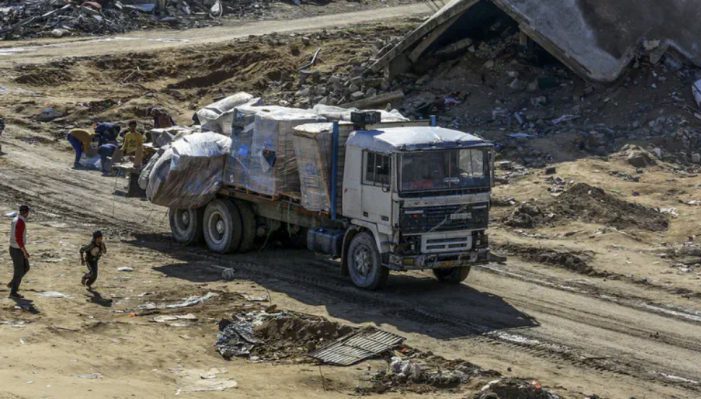Iran’s nuclear program exhibits concerning parallels with those of North Korea, India, Pakistan, and Israel, marked by a history of deception, but radically differing from them in its alarming rhetoric of genocidal threats against Israel. The risks posed by a nuclear-armed Iran significantly outweigh those of other nations. Op-ed.
Despite the Trump Administration’s assurances that Iran will never possess nuclear weapons and the optimism of U.S. delegates at the Oman talks, Iran is steadily advancing toward joining the nuclear club.
In truth, the Oman negotiations are a diplomatic ruse—a sedative slipped into the drink offered to Witkoff and his team of brilliant but dangerously naïve experts. These talks buy Iran time to advance its nuclear ambitions. They’re a carefully dosed Valium, designed to lull the United States until Iran unveils its Big Bang: a triumphant announcement of its nuclear arsenal. Once that moment arrives, no threats will hold sway. The plan is clear—and it’s unfolding in plain sight.
How do I know? History provides the blueprint. North Korea, India, Pakistan, and even Israel have all used deception to conceal nuclear development under the noses of vigilant inspectors. Despite meticulous scrutiny, critical work was hidden just beneath the surface.
Take North Korea. Its nuclear program thrived on deception, evasion, and manipulation of diplomatic processes. In the 1980s, North Korea embraced nuclear ambiguity, joining the Nuclear Non-Proliferation Treaty (NPT) in 1985 to avoid sanctions while delaying the safeguards agreement needed for International Atomic Energy Agency (IAEA) inspections. By the early 1990s, the IAEA uncovered discrepancies in North Korea’s declared nuclear material, suspecting clandestine plutonium separation. North Korea’s refusal to allow special inspections sparked a crisis.
In 1994, North Korea agreed to freeze its plutonium program in exchange for aid, light-water reactors, and normalized U.S. relations. Yet, it secretly pursued uranium enrichment, violating the spirit—and likely the letter—of the deal. In 2003, citing U.S. hostility, North Korea withdrew from the NPT and openly restarted its nuclear program after years of covert progress. Its first nuclear test in 2006 confirmed its weapons capability. During the Six-Party Talks (2003–2009) and beyond, North Korea repeatedly promised denuclearization for aid, only to renege and advance its nuclear and missile programs.
North Korea’s strategy was calculated:
- Engage in treaties to deflect sanctions or attacks.
- Use delay tactics and misinformation.
- Run covert programs while publicly freezing others.
- Exploit diplomatic talks for economic gain and time.
This playbook of deception and strategic patience made North Korea a nuclear-armed state despite global opposition.
Does this sound familiar? Iran’s actions mirror North Korea’s. The Oman talks, like past negotiations, risk being another stall tactic, allowing Iran to edge closer to its nuclear goal while the world watches.
Now let’s take a look at India.
India’s path to nuclear weapons involved deliberate ambiguity and calculated deception, especially early on. Unlike North Korea’s approach, India portrayed peaceful intentions while secretly aiming for nuclear capability, misleading partners like Canada and the US who provided civilian nuclear technology (like the CIRUS reactor and heavy water) under peaceful-use agreements.
India’s 1974 “peaceful nuclear explosion,” using plutonium from this reactor, was seen as a breach of trust. Subsequently, India maintained strategic ambiguity, refusing to sign the NPT but developing nuclear infrastructure. This ended in 1998 with open nuclear tests and a declaration of nuclear statehood, confirming long-held suspicions of weaponization. The US initially imposed sanctions but later, through the 2008 Civil Nuclear Agreement, implicitly accepted India’s nuclear status outside the NPT.
India’s nuclear success stemmed from diverting civilian partnerships to military ends, strategic opacity, and a final reveal in 1998, built on deception in its early interactions.
Let’s look at Pakistan.
Pakistan’s development of nuclear weapons, particularly from the 1970s to the 1990s, heavily relied on deception, secrecy, and covert international procurement. Driven by the urgent need for a nuclear deterrent after India’s 1974 test, Pakistan publicly denied its nuclear ambitions while secretly initiating a bomb program. Key to this was Dr. A.Q. Khan’s theft of centrifuge designs and the establishment of a clandestine procurement network using front companies and false documentation to acquire materials and equipment from various countries.
Diplomatically, Pakistan repeatedly assured the international community, especially the US, that it was not pursuing nuclear weapons, even exploiting Cold War dynamics to maintain US aid despite growing evidence to the contrary. Pakistan’s nuclear capability was finally confirmed in May 1998 with its nuclear tests. The subsequent revelation of A.Q. Khan’s black-market proliferation network further underscored the deceptive nature of Pakistan’s nuclear journey.
In summary, Pakistan achieved nuclear status by stealing technology, deceiving international allies and watchdogs, building a covert infrastructure, and leveraging geopolitical situations.
Yes, India developed its nuclear bomb under a strategy of deliberate ambiguity and deception, especially in its early stages. While India’s approach was somewhat different from Pakistan’s or North Korea’s, it still involved misleading other nations—particularly Canada and the United States—about the intended use of imported civilian nuclear technology.
Let’s look at Israel’s covert path to Nuclear Power
Israel’s development of nuclear weapons, beginning in the late 1950s, was characterized by a sophisticated and sustained campaign of deception. Under the guise of a “textile plant” or “research reactor,” France secretly helped Israel build the Dimona nuclear facility, designed from its inception to produce plutonium for weapons. When the US discovered Dimona, Israel falsely claimed it was for peaceful research. Key technology, engineers, and materials, including a plutonium separation plant, were provided by France, while Norway unknowingly supplied heavy water for the reactor. Israeli scientists also gained expertise abroad under peaceful pretenses, all while the program’s true military intent remained concealed.
Throughout the 1960s, Israel strategically deceived the US during inspections of Dimona. False walls, fake control rooms, and heavily managed tours prevented American officials from uncovering the weapons-related operations. Prime Minister Ben-Gurion falsely assured President Kennedy of the program’s peaceful nature. By the late 1960s, having produced enough plutonium for bombs, Israel adopted a doctrine of “strategic ambiguity,” famously stating, “We will not be the first to introduce nuclear weapons into the Middle East.” This deliberately vague statement neither confirmed nor denied possession.
In 1969, a tacit “don’t ask, don’t tell” agreement was reached between Israeli Prime Minister Golda Meir and US President Richard Nixon, where the US tolerated Israel’s undeclared nuclear arsenal as long as it remained unacknowledged and untested. The 1979 Vela Incident, the detection of a double flash potentially indicating a joint Israeli-South African nuclear test, further fueled suspicions of ongoing deception, though the US officially deemed the cause “inconclusive.”
The extent of Israel’s program was revealed in 1986 by Mordechai Vanunu, a former Dimona technician who provided evidence of warhead production. His subsequent kidnapping and imprisonment by Mossad underscored Israel’s commitment to secrecy.
Despite never officially declaring its status, Israel is widely considered the Middle East’s sole nuclear-armed state, possessing a significant arsenal acquired outside the NPT through a strategy built on false statements to allies, misleading inspections, foreign assistance under false pretenses, deliberate ambiguity, and the suppression of information.
Israel’s nuclear status is notable because it hasn’t spurred its Arab neighbors to pursue their own nuclear weapons. It did not lead to a nuclear arms race. This is largely attributed to the understanding that Israel would only use such capabilities in response to a similar attack.
This dynamic starkly contrasts with the situation involving Iran.
Iran’s obvious emulation of all of the above deception tactics.
Iran’s nuclear program has been marked by consistent deception and concealment. In 2002, previously undisclosed uranium enrichment (Natanz) and heavy water (Arak) facilities were revealed, violating NPT obligations. Throughout the 2000s, Iran provided false or incomplete declarations to the IAEA, underreporting enrichment, hiding procurement through front companies, and delaying or obstructing inspections.
The 2018 revelation of the “Amad Plan” from seized Iranian documents exposed a secret nuclear weapons program from the late 1990s to the early 2000s, focused on warhead design, testing facilities, and missile integration. While formally shelved after 2003, its elements likely continued covertly. Iran has also repeatedly exceeded JCPOA uranium enrichment limits post-US withdrawal and the IAEA has found undeclared nuclear material at undisclosed sites, raising further concerns.
Iran has consistently concealed the “Possible Military Dimensions” of its program, stonewalling IAEA inquiries and hiding weapons-related equipment and personnel behind civilian fronts. Furthermore, Iran has employed diplomacy as a tactic to delay sanctions and buy time, often selectively implementing or later backtracking on agreements. In summary,
Iran’s nuclear development involves undisclosed facilities, lies to the international community, a covert weapons program, and obstruction of inspections, severely undermining its claims of a purely peaceful nuclear program.
Iran’s nuclear program exhibits concerning parallels with those of North Korea, India, Pakistan, and Israel, marked by a history of deception, but also differing from them in its alarming rhetoric, including genocidal threats against Israel.
The US administration’s belief that it can succeed where previous efforts failed appears dangerously and naively optimistic, especially given the heightened stakes and Iran’s urgent perceived need for a nuclear deterrent in the face of US threats. The risks posed by a nuclear-armed Iran significantly outweigh those of other nations. Therefore, elimination of Iran’s nuclear program by force followed by a working program leading to a regime change within Iran is presented as the only viable solution to prevent a nuclear nightmare, making it the primary objective of US policy.
Continued negotiations are deemed futile, simply deceptive illusions for naive leaders.





